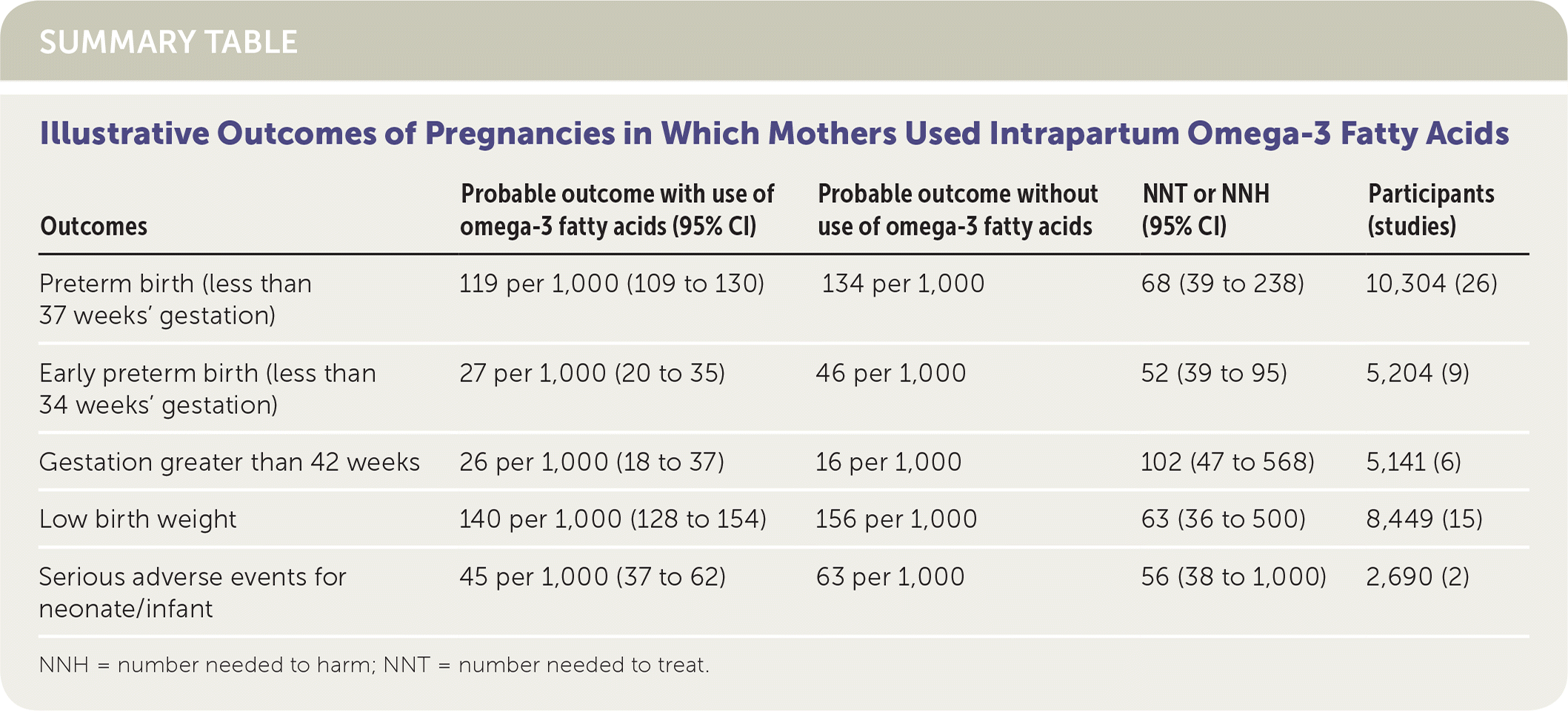
Am Fam Physician. 2020;101(1):17-18
Clinical Question
Are omega-3 fatty acids safe and effective for reducing the risk of preterm birth (before 37 weeks’ gestation) and early preterm birth (before 34 weeks’ gestation)?
Evidence-Based Answer
Omega-3 fatty acids, whether taken as supplements or consumed as part of the diet, reduce the risk of preterm birth (number needed to treat = 68) and early preterm birth (number needed to treat = 55). However, they also increase the risk of prolonged gestation (more than 42 weeks; number needed to harm = 102).1 (Strength of Recommendation: A, based on consistent, good-quality patient-oriented evidence.)
Practice Pointers
Preterm birth accounts for 85% of perinatal complications and deaths,2 and the percentage is increasing in the United States.3 Previous observational and cohort studies have suggested that omega-3 fatty acid intake can reduce the risk of preterm birth.1 A recent study in Norway evaluated food and supplement intake in a cohort of 67,000 pregnant women. It showed that seafood consumption was associated with a lower prevalence of preterm delivery, whereas use of omega-3 supplements resulted in a lower prevalence only of early preterm delivery.4 (The authors did not specify the type of seafood consumed.) The anti-inflammatory properties of omega-3 fatty acids may be the mechanism by which intake influences delivery timing.1 The primary outcomes discussed in this review were preterm birth, early preterm birth, and prolonged gestation in relation to omega-3 fatty acid intake in any form. The authors also investigated a number of secondary outcomes involving maternal, perinatal, neonatal, and child health.
This Cochrane review, which included 70 randomized controlled trials and 19,927 women, compared omega-3 fatty acid intake to placebo or no intake.1 Omega-3 fatty acid intake involved using supplements, eating foods rich in omega-3 fatty acids, or receiving advice to consume these types of foods. The studies included women at low, high, and mixed risk of poor pregnancy outcomes based on a combination of factors, including history and age. Most of the studies investigated the effect of omega-3 fatty acids in the form of supplements. The study-level risk of bias was mixed. Most trials were conducted in upper-middle income or high-income countries, with the highest number conducted in the United States.
Patients who used omega-3 fatty acids demonstrated a reduced risk of preterm birth (11.9% vs. 13.4% in those who did not use them; relative risk [RR] = 0.89; 95% CI, 0.81 to 0.97), as well as a reduced risk of early preterm birth (2.7% vs. 4.6%; RR = 0.58; 95% CI, 0.44 to 0.77). A subgroup analysis showed a decreased risk of prelabor rupture of membranes in those using omega-3 fatty acids (RR = 0.46; 95% CI, 0.28 to 0.76; four trials; 1,281 participants). However, omega-3 fatty acid intake increased the risk of prolonged gestation (2.6% vs. 1.6%; RR = 1.61; 95% CI, 1.11 to 2.33).
The studies also demonstrated a reduced risk of low birth weight with omega-3 fatty acids (14% vs. 15.6%; RR = 0.90; 95% CI, 0.82 to 0.99). There were no statistically significant differences in maternal outcomes. In addition, the authors evaluated a variety of neurodevelopmental and growth outcomes in children but concluded that there were no differences between those who were treated and those who were not.
The 2012 American College of Obstetricians and Gynecologists practice bulletin, “Prediction and Prevention of Preterm Birth,” does not make a recommendation about using omega-3 fatty acids to prevent preterm birth.5 Since then, several systematic reviews and meta-analyses have been published about whether supplementation decreases the risk of preterm birth. The results of three studies were consistent with those of the Cochrane review in demonstrating that omega-3 fatty acids reduce the risk of preterm birth,6–8 but two other studies showed no difference.9,10 The one large systematic review from the Agency for Healthcare Research and Quality acknowledged a longer duration of gestation but found no overall change in the risk of preterm birth, suggesting that this prolonged duration of pregnancy may not be clinically relevant. The authors of that review concluded that the studies had an overall low strength of evidence.10 According to this Cochrane review, omega-3 fatty acid intake can be an effective way to reduce the risk of preterm birth, but the clinical context of the individual patient should be taken into consideration given the possibility of increased length of gestation. It is worth noting that in the United States it is standard of care to consider induction of labor in any woman whose gestation reaches 41 0/7 weeks.

| Outcomes | Probable outcome with use of omega-3 fatty acids (95% CI) | Probable outcome without use of omega-3 fatty acids | NNT or NNH (95% CI) | Participants (studies) |
|---|---|---|---|---|
| Preterm birth (less than 37 weeks’ gestation) | 119 per 1,000 (109 to 130) | 134 per 1,000 | 68 (39 to 238) | 10,304 (26) |
| Early preterm birth (less than 34 weeks’ gestation) | 27 per 1,000 (20 to 35) | 46 per 1,000 | 52 (39 to 95) | 5,204 (9) |
| Gestation greater than 42 weeks | 26 per 1,000 (18 to 37) | 16 per 1,000 | 102 (47 to 568) | 5,141 (6) |
| Low birth weight | 140 per 1,000 (128 to 154) | 156 per 1,000 | 63 (36 to 500) | 8,449 (15) |
| Serious adverse events for neonate/infant | 45 per 1,000 (37 to 62) | 63 per 1,000 | 56 (38 to 1,000) | 2,690 (2) |
The practice recommendations in this activity are available at http://www.cochrane.org/CD003402.
Editor's Note: The numbers needed to treat reported in this Cochrane for Clinicians were calculated by the authors based on raw data provided in the original Cochrane review. Dr. Fogleman is an assistant medical editor for AFP.
